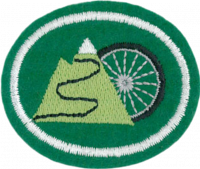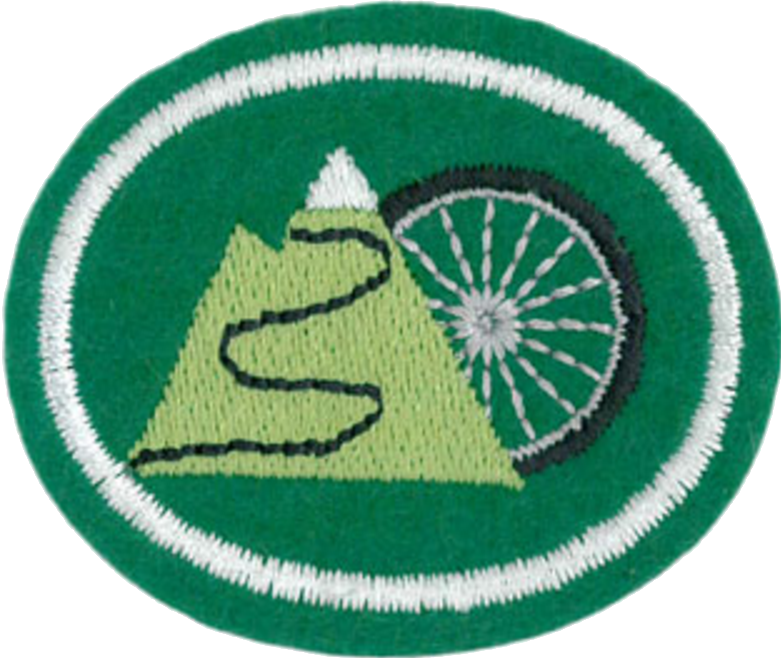AY Honors/Mountain Biking/Answer Key
1
For tips and instruction see Cycling.
2
- Tires - Mountain bikes have knobbie tires for gripping the trail. Road bikes have slick tires to minimize rolling resistance, increasing speed and ease of riding.
- Handlebars - Mountain bikes have a wide, flat handlebar to allow better control and a more upright riding style to allow better vision of the trail. Road bikes have a narrower, dropped (downward curved) handlebar to allow more riding positions and more aerodynamics.
- Gearing - Most Mountain bikes have three chainrings (44/36/22) paired with a 7, 8, or 9 speed cassette. Most Road bikes have two chainrings (53/39), larger than a Mountain bike, paired with a smaller 9 or 10 speed cassette. The larger gear ratios on a Road bike allow greater speed on smooth surfaces.
- Shifters / Brake Levers - Mountain bikes have a horizontal brake lever paired with a trigger shifter (rapidfire) or a twist shifter (GripShift). Road bikes have either an integrated vertical lever, meaning that the brake lever is also used for shifting by pushing the lever to the side, or a vertical brake lever paired with downtube shifters, paddle levers on the sides of the downtube used for shifting.
- Wheels - Mountain bike wheels are typically 26 inch wheels, although 29 inch wheels are becoming popular among experienced riders. The rims are sturdy, made to stand up to the abuse of a rough trail. There are many spokes, to support the rim and the hub is beefy to provide a strong foundation. Road bike wheels are typically 700c though 650c wheels are occasionally used by smaller riders. The rims are light, but strong, and are shaped to provide little wind resistance. There are normally fewer spokes that are occasionally bladed (flattened) to cut through the wind. The hub is smaller to provide less of an obstacle for the wind, but is still very strong. Road wheels, however, could not likely stand up to the constant pounding that Mountain bike wheels can.
3
4
- Steel
- Aluminum or Aluminum Alloy
- Titanium
- Carbon Fiber
New materials are being researched to find stiffer, lighter, and more durable frame options.
5
The essential feature of single track is that it is narrow. In addition it is frequently smooth and flowing, but it may also exhibit technical rocky sections and may be criss-crossed with tree roots. Single track contrasts with double track or fire road which is wide enough for four-wheeled off-road vehicles.
6
A "hard tail" mountain bike only has suspension on the fork, whereas a "full suspension" mountain bike has two suspension devices (one on the fork and one supporting the rear tire from the frame).
A few advantages of having a "hard tail" are that it costs less, has fewer components that can break, and is much easier to operate when climbing up hills.
On the other hand, some of the advantages of a "full suspension" mountain bike are that they are more comfortable (even on rough terrain), can handle greater abuse when riding tough trails, and can be adjusted to fit a number of different types of terrain.
7
Rules vary across countries and regions. Know the local customs and rules of where you plan to ride before starting your ride. Trails and roads are shared with other users. Be courteous of other users and leave plenty of distance as you pass or stop and let them pass. In the United States, it is commonly required that mountain bikers always yield to hikers and horse riders. This means stopping and letting them pass or walking your bike past them.
It is also important to be courteous of other mountain bikers. If you come up behind another rider, call out before you pass them to avoid scaring them. Call something such as, "passing on your left" before getting too close. Another place where it is important to call out is a trail intersection. This is important if you do not plan to stop at the intersection. Other riders may be coming fast. To avoid a crash call out loudly before crossing the trail intersection. Simply shouting, "call out" is a common phrase used to alert other riders you are crossing the trail intersection without stopping. This means it is important that you also listen for other riders calling out as they approach the intersection. If you hear someone else call out, stop to avoid a collision.
The International Mountain Biking Association has developed the following courtesy rules. Practicing them helps keep everyone safe and keep mountain biking trails open. 1) Ride on open trails only. If a trail is marked as closed, do not ride there. 2) Leave no trace. This means picking up any trash you bring. The only trace you should be leaving are your tire tracks! 3) Control your bicycle. Ride within your ability. You are responsible for your bike and where it goes. If a steep hill or jump looks too big for you, it probably is. Obey all local laws and rules. 4) Yield to others. Bicyclists usually yield to all other trail users. 5) Never scare animals. It may happen by accident. Try your best to avoid scaring them. 6) Plan ahead. Tell someone where you are going. Did you pack your helmet? Double check. Have a map of the trails if possible. Bring any tools, spare tubes or air pumps you may need. Always carry a first aid kit.
8
- Helmet
- Closed Toe Shoes or biking shoes
- Gloves
- Protective Eyewear
9
Commonly Broken Bones
Injury Prevention
To prevent injuries from occurring be sure to make choices that decrease the risk of injury-(all injury).
- Wear protective gear.
- Choose trails appropriate to your riding ability and riding experience.
- Be physically fit enough for the trail you choose to ride. Do not ride when fatigued!
- Keep bike in top mechanical shape. When mountain biking, bikes should be checked and properly maintained before every ride.
10
11
- a. Three 5 mile rides.
- b. Two 10 mile rides.
- c. One 20 mile ride.
- a. Three 5 mile rides.
- b. Two 10 mile rides.
- c. One 20 mile ride.
Use a GPS or time riding a known length of trail so you can know how long a ride took. Keep a log of where, when, and how far you rode to prove you completed this requirement. Happy riding.


